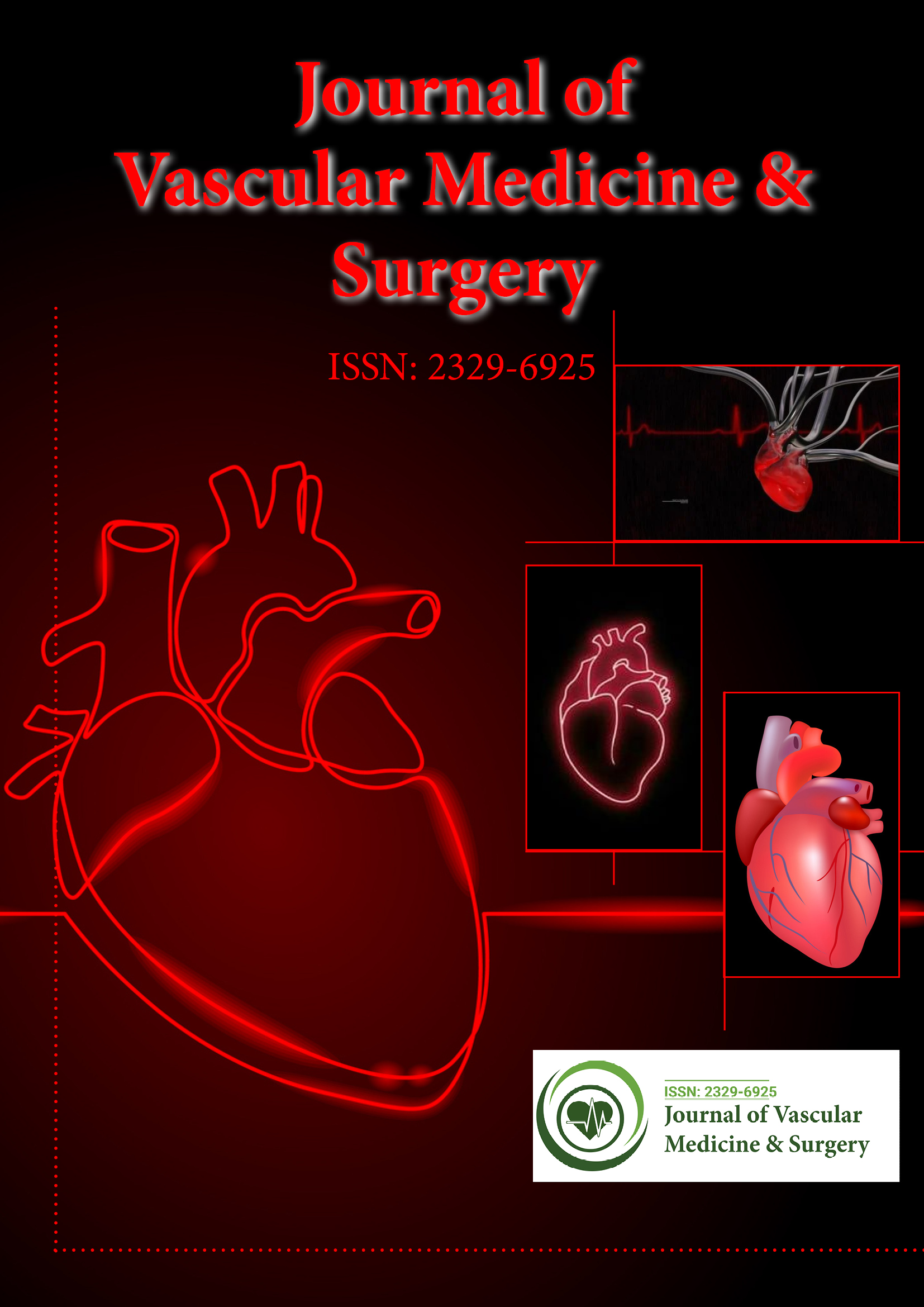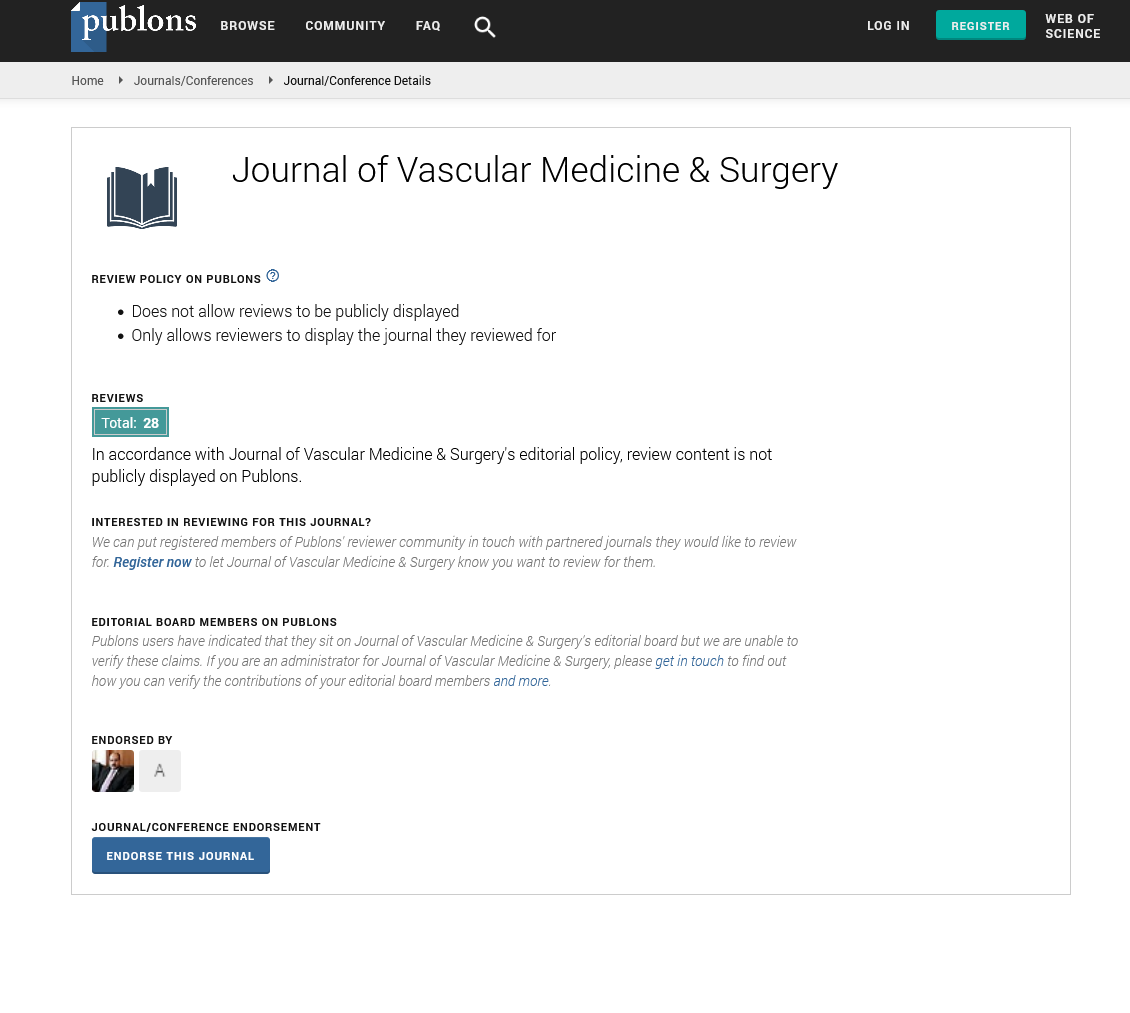Indexed In
- Open J Gate
- Academic Keys
- RefSeek
- Hamdard University
- EBSCO A-Z
- OCLC- WorldCat
- Publons
- Euro Pub
- Google Scholar
- SHERPA ROMEO
Useful Links
Share This Page
Journal Flyer

Open Access Journals
- Agri and Aquaculture
- Biochemistry
- Bioinformatics & Systems Biology
- Business & Management
- Chemistry
- Clinical Sciences
- Engineering
- Food & Nutrition
- General Science
- Genetics & Molecular Biology
- Immunology & Microbiology
- Medical Sciences
- Neuroscience & Psychology
- Nursing & Health Care
- Pharmaceutical Sciences
Opinion - (2025) Volume 13, Issue 8
Bridging Research and Practice in Vascular Medicine
Jasper Zachary*Received: 21-Jul-2025, Manuscript No. JVMS-25-29908; Editor assigned: 23-Jul-2025, Pre QC No. JVMS-25-29908 (PQ); Reviewed: 06-Aug-2025, QC No. JVMS-25-29908; Revised: 13-Aug-2025, Manuscript No. JVMS-25-29908 (R); Published: 20-Aug-2025, DOI: 10.35248/2329-6925.25.13.611
Description
In the rapidly evolving field of vascular medicine, the gap between research and clinical practice has long posed a challenge. As vascular diseases remain a significant contributor to global morbidity and mortality, the need to bridge the divide between research and practice has never been more urgent. Doing so promises not only to accelerate the implementation of evidence-based interventions but also to enhance patient outcomes, reduce healthcare costs, and foster a more adaptive, responsive healthcare system.
Bridging this divide requires more than merely publishing findings or updating guidelines. It demands a cohesive, dynamic approach that aligns scientific exploration with real-world clinical needs. This commentary explores how integrating research and practice in vascular medicine is both a necessity and an opportunity to revolutionize the future of vascular care.
Translational gaps: understanding the divide
Vascular medicine has yielded a wealth of insights into disease mechanisms, novel therapeutic targets, and innovative treatment strategies. From the development of endovascular interventions to advancements in pharmacology and imaging, the potential for improving vascular care is immense. However, a persistent challenge lies in ensuring that these advancements are effectively translated from bench to bedside.
Several factors contribute to this gap. First, the traditional research model often operates in isolation from clinical practice. Research studies are frequently designed in highly controlled settings that do not account for the complexities and variability of real-world patient populations. As a result, interventions that demonstrate efficacy in trials may underperform or face logistical barriers when implemented in routine care.
Second, there is a lag in the dissemination and adoption of new evidence. Even when new therapies or diagnostic tools receive regulatory approval, it may take years for them to become widely adopted in clinical settings. This delay is exacerbated by lack of awareness, insufficient training, or hesitation among clinicians to depart from established practices.
Furthermore, clinical guidelines—while crucial—are not always updated in real time to reflect the latest evidence. This can create confusion among practitioners and limit the integration of cutting-edge knowledge into daily decision-making. In some cases, institutional inertia or limited resources can also impede the implementation of novel interventions, especially in under-resourced healthcare systems.
Perhaps most critically, there is often insufficient feedback from clinicians back into the research process. Valuable insights gained from frontline experience are rarely captured systematically, which prevents researchers from refining and adapting their work based on practical realities. Without a two-way exchange between researchers and practitioners, the system remains disconnected, and opportunities for meaningful advancement are lost.
Building bridges: strategies for integration
Closing the gap between research and practice in vascular medicine demands a deliberate, structured approach grounded in collaboration, communication, and continuous learning. One of the most powerful strategies is the establishment of translational research networks that bring together researchers, clinicians, healthcare administrators, and patients. These multidisciplinary teams can co-design studies that are not only scientifically rigorous but also practically relevant, ensuring that the findings are applicable to diverse clinical settings.
Clinician involvement at every stage of the research process is crucial. By engaging practitioners in the identification of research questions, design of protocols, and interpretation of results, research becomes more aligned with actual clinical needs. Likewise, embedding researchers within clinical environments fosters a deeper understanding of day-to-day challenges and helps identify areas where innovation is most urgently needed.
The use of implementation science—a field focused on understanding how to effectively adopt and integrate evidence-based practices—is gaining traction in vascular medicine. Implementation science examines the factors that facilitate or hinder the uptake of research findings, providing tools to accelerate their adoption in real-world settings. Through pilot programs, quality improvement initiatives, and data-driven feedback loops, it is possible to test and refine interventions before scaling them system-wide.
Digital health technologies also play a pivotal role in bridging research and practice. Electronic Health Records (EHRs), clinical decision support systems, and remote monitoring tools can be leveraged to gather real-time data on treatment effectiveness, adherence, and patient outcomes. These data not only inform clinical practice but can also be fed back into research databases, creating a continuous cycle of evidence generation and application.
Education and training are equally vital. Clinicians must be equipped with the knowledge and skills to understand and implement new research findings. This includes not just continuing medical education, but also fostering a culture of inquiry and lifelong learning. Incorporating research literacy into the training of vascular specialists ensures that future generations of clinicians are better prepared to engage with and apply emerging evidence.
Conclusion
In conclusion, innovative clinical approaches are fundamentally changing the landscape of vascular disease management. Through minimally invasive procedures, personalized medicine, advanced diagnostics, and digital health technologies, these innovations are improving the precision, safety, and effectiveness of vascular care. The result is better patient outcomes reduced complications, improved survival rates, and enhanced quality of life. As the field continues to evolve, a commitment to equitable access, ongoing education, and ethical practice will be essential to ensure that these transformative benefits reach all patients in need. The future of vascular medicine, driven by innovation, holds immense potential to reduce the global burden of vascular diseases and improve health for millions worldwide.
Citation: Zachary J (2025). Bridging Research and Practice in Vascular Medicine. J Vasc Surg. 13:611.
Copyright: © 2025 Zachary J. This is an open-access article distributed under the terms of the Creative Commons Attribution License, which permits unrestricted use, distribution and reproduction in any medium, provided the original author and source are credited

